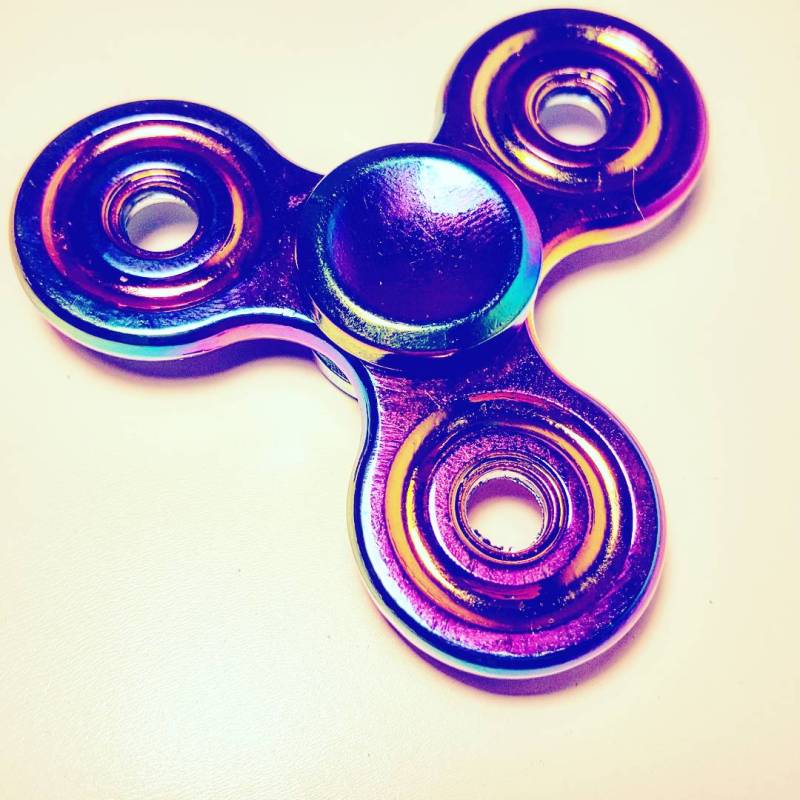Ah, fidget spinners, the ubiquitous and dividing product of our times. I don’t know when I first became aware of their existence, but I am very aware of that existence now. You’ve probably seen them; if not being played with by idle hands then in one of the many articles bemoaning their questionable mental health benefits. Anecdotal proof of their ubiquity comes from the fact that when I spontaneously decided to buy one late on a Saturday afternoon, all I had to do was walk 30 seconds past the Tesco in central Bedford and I immediately found a market stall selling fidget spinners in a plethora of sizes and colours.
What is it?
There are many different types of fidget spinner but the most basic tends to consist of a centre pad with a bearing in it, held between the thumb and forefinger, and two or three prongs which are manually spun around it. They’re made from multiple materials, with the cheapest formed of plastic components but brass, stainless steel, titanium and copper alternatives are also available. Spinners are typically marketed as stress relieving and as a work aid for those who have trouble focusing (for example, one fidget spinner on Amazon is marketed as ‘Fidget Spinner, Greatever EDC Tri Fidget Hand Spinning Toy Time Killer Stress Reducer High Speed Focus Toy Gifts Perfect for ADD, ADHD, Anxiety, Boredom and Autism Adult Kids’). Some have defended their usage as a legitimate aid to concentration and have pointed out the cruelty of spinner snobbery when it might prevent someone from using what is essentially an inexpensive tool to help them focus and fidget in a less self-destructive way. Others have criticised spinners for being distracting, as just another vacuous gimmick with no proven health benefits, and even potentially dangerous.
![xUOrwrXdGcUbjUFo8o[1]](https://florencesmithnicholls.com/wp-content/uploads/2017/06/xuorwrxdgcubjufo8o1.gif?w=770)
What does this have to do with archaeology?
Given the controversy over their usage and the widespread irritation they seem to generate it may seem a bit strange that I would try to conflate fidget spinners with archaeology, let alone write about them at all. The inspiration for this blog post came after reading two separate pieces on spinners, one suggesting that the spinner fad is ‘over’ and the other on the fact that German Customs Officials have apparently seized 35 metric tons of fidget spinners which they have deemed dangerous and plan to destroy. Given the fact that the peak of fidget spinner production, purchase and use is likely to be limited to a small time frame before they are inevitably discarded, I started to wonder about the potential of fidget spinners as archaeological artefacts. How will future archaeologists interpret them?
The question of interpretation hinges on several key factors. Of course, context is always key in archaeology, and the nature of the context in which the spinner or spinners are found, and their state of preservation, will be crucial. Given that plastic can take hundreds of years to fully degrade even the cheapest fidget spinners could last centuries into the future. For this reason, it is hoped that as many fidget spinners as possible will be recycled rather than end up in landfill. Either way, many fidget spinners are potentially unlikely to be deposited in their location of original use, with future chance finds likely to be a result of accidental or deliberate loss through littering.
If spinners are discovered within the next hundred years, it is likely that there will be existing memories or documentation which survives to aid identification. However, beyond this, their interpretation may be highly reliant on the endurance of digital records. There are multiple existing web archiving initiatives, such as the Internet Archive, a non-profit library which has been archiving web pages since 1996 through the Wayback Machine. Just as real-world archaeological artefacts are subject to decomposition over time, web pages can easily be subject to ‘link rot,’ when such a page no longer exists or a server that hosts the target page has stopped working or relocated, among many other reasons. Searching on the Internet Archive for “fidget spinners” unsurprisingly brings up multiple archived web pages and videos on the subject. However, though the Internet Archive aims to preserve such resources for future research, it is impossible to know if it will still be accessible hundreds of years into the future. A case in point-the inauguration of Trump as President of the United States posed such a perceived existential threat to the Internet Archive that a Canadian copy of it was announced as a safeguard.
In the event that there are no digital or analogue sources to aid the interpretation of a fidget spinner excavated hundreds of years in the future, they might be impossible to conclusively identify. Such a situation is analogous to contemporary confusion over particular archaeological artefacts. For example, Minoan and Myceneaen Bronze Age pierres à cupules (circular holes cut into stone slabs, typically in a circular or oval pattern but there are multiple variations) have been interpreted as religious paraphernalia as well as monumental game boards. When you consider that fidget spinners have multiple contemporary uses and perceived purposes, this compounds the problem even more. If one future archaeologist interpreted them as a ‘tool’ and another as a ‘toy,’ would either of them be strictly ‘wrong’? If we consider the pierres à cupules in light of this, a ‘religious’ function doesn’t seem particularly incompatible with a recreational one-the two may not have been mutually exclusive in the past if they were even considered in those terms at all.
This has formed an initial piece on fidget spinners as an aid to an archaeological thought experiment, perhaps proving that (at least in this sense) they can be a tool and not just a nuisance. In my next piece I’ll be taking another ‘spin’ at fidget spinner archaeology, considering digital fidget spinners as immaterial culture.
Photograph and GIF produced by the author


You have a gift for satire. This is a compliment.
LikeLike